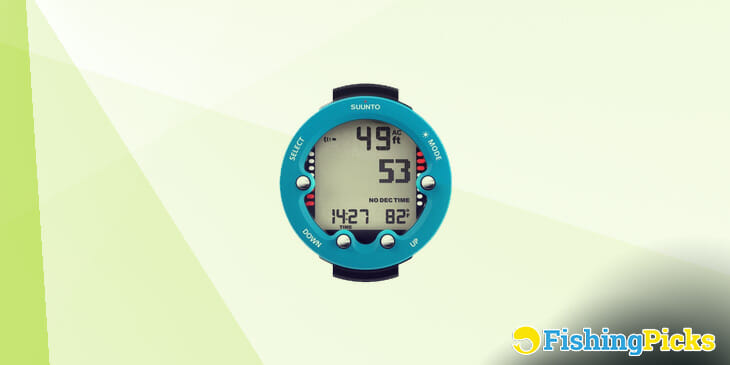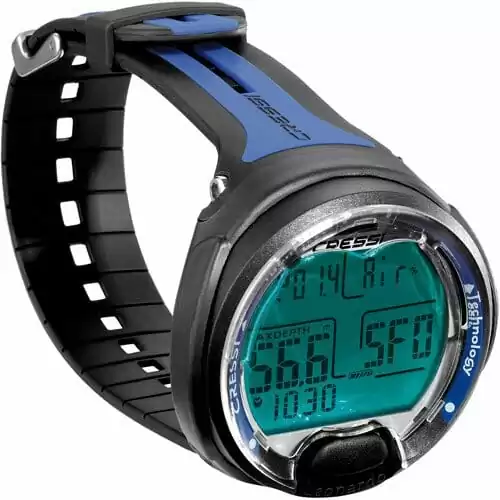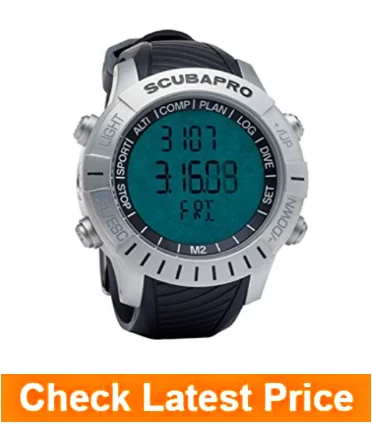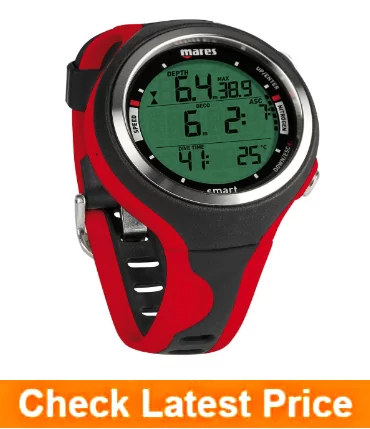The Best Dive Computers in 2022 – Complete Buyer’s Guide
Finding the dive computer that will accommodate all your needs requires a bit of patience, a bit of knowledge, and reading along to discover the different options and the features they offer.
Our comprehensive review aims to cover all the bases—here you will find many reliable options from basic models that won’t get you very far, to devices that would seem far more at home on the bridge of a spaceship. Check out our list of the best dive computers so you can have your pick from the top models.
Best Dive Computers - Comparisons
Image | Product Name | Color | Dimensions | Price |
|---|---|---|---|---|
Black | 1 x 1 x 1 inches | |||
blue | 5 x 5 x 4 inches | |||
Black/Blue | 4 x 4 x 4 inches | |||
Black | 6 x 6 x 3 inches | |||
Black/Red | 6 x 6 x 6 inches |
5 Best Dive Computers - Reviews
The Petrel 2 from Shearwater Research is arguably the best and most advanced dive computer on the market at the minute. Cutting-edge technology coupled with a full-colour LCD screen and large numbers ensures that this computer stays visible in all conditions.
Key features include:
- Choice of algorithm (ZHL16 or VPM-B)
- 300 m/985 ft depth rating
- Full trimix capabilities including rebreather support
- Accelerated decompression when dive planning
- Will take any AA battery
This piece of gear has some powerful functions and the capability to calculate decompression for every kind of dive from standard air diving to Helium-based re breather dives. The Shear water Petrel is an excellent piece of gear that can be used by anyone from novice divers to the most advanced technical divers out there.
What we liked
- Crystal clear screen
- Big and easy-to-read numbers
- Large amount of data available to analyse your dive
- Dive data easily downloadable via USB Bluetooth adapter
What we didn't like
- Getting used to the computer requires some practice
- Can be a little confusing for novice divers
Even though it comes at an affordable price, this budget computer has all the functions most divers will ever need. It is Nitrox-capable and the big screen and clear numbers of the display are easy to read.
Its key features include:
- 80 m/260 ft maximum operating depth
- Ascent speed warning alarm
- 140 hours logbook memory
- Suunto RGBM decompression algorithm
Matching the design of many previous Suunto models, the Zoop Novo looks and feels like an old friend—if you have used a Suunto wrist computer before, you will love the upgrades the Zoop Novo has to offer. It features Suunto’s established and proven RGBM algorithm for safe diving, and has 4 distinct diving modes: Air, Nitrox, Gauge, and Freedive.
What we liked
- Intuitive to use
- 4 buttons allow easy menu navigation
- Can be console or wrist-mounted
- Data downloadable via USB cable
What we didn't like
- Limited functionality for technicaldiving
- Difficult to operate with thick gloves on
- Can only use Nitrox up to 50%
The Leonardo is the perfect example of a simple, easy-to-use, and functional dive computer. It has the general features that you would expect in a basic dive computer as well as some advanced safety features including:
Safety Features
- RGBM decompression algorithm plus optional deep stops
- Nitrox from 21% to 50%
- 60 hours or 75 dives logbook
- Ascent speed warning alarm
Although technical divers would find it too bare-bones, it is a great piece of gear for recreational divers as it is very robust and tough and can easily last a long time. For divers who just want to dive, the Cressi Leonardo can be the perfect diving companion.
What we liked
- Has all the basic functions
- Deep stops incorporated for additional safety
- Tool-less battery change
What we didn't like
- The one-button interface takes some getting used to
- Matrix letters on the screen are difficult to read
- Screen can feel a little over-crowded
The Mantis 2 (M2) is a great-looking watch-style dive computer with a stylish design that resembles classic deep-sea diving watches.
This computer comes with a whole host of features that will meet almost every divers’ needs—they evenincorporated Scubapro’s cutting-edge Human Factor Diving technology which, when combined with the Scubapro heart rate monitor, will notify you when you are overexerted.
Key features of the Mantis 2 include:
- 120 m/395 ft depth rating
- Scubapro ZHL8 ADT MB algorithm
- Nitrox gases from 21% to 100%
- Built-in digital compass
The monitor also measures the diver’s skin temperature which then you can take into account when calculating your decompression status. You can also monitor several tanks via hoseless transmitters. Overall, the M2 is one of the most advanced watch-style computers out there.
What we liked
- 3 gases up to 100% Oxygen
- Can handle rebreather (CCR) diving
- Great-looking piece of equipment
What we didn't like
- Takes some time to get used to the
- Due to its size, the numbers can be a little on the small side
- Buttons are difficult to use in cold water with thick gloves
The Smart from Mares builds on the success of their previous model, the Puck, and incorporates the same bright display. It is a two-button computer that supports Nitrox diving up to 100% Oxygen and gas switches during diving. The computer has a free-diving mode with its own dedicated alarms which allows you to set alarms for when you’ve reached your target depth or once a set amount of time has elapsed.
Other key features include:
- 150 m/492 ft depth rating
- Nitrox from 21% to 99%
- 20 hours logbook capacity
- Fresh and saltwater setting for enhanced accuracy
The Mares Smart supports up to 36 hours of log book capacity, and dive data can be downloaded. To keep the computer current and up-to-date, the Mares Dive Organiser (for PC) or the Diver’s Diary (for MAC) can be used to update its firmware to the latest version from Mares.
What we liked
- The ability to use Nitrox up to 100%
- Nitrox up to 100% for decompression
- Stylish design and multiple colour options
What we didn't like
- Like a lot of watch-style computers, numbers can be a little small
- Strap can be a little short to put on over a thick wetsuit or drysuit
Choosing The Best Dive Computer
There are several factors you need to consider when purchasing a new dive computer. Ignoring these could mean that after a short while you end up with a computer that does not meet your needs anymore, or worse, a computer that places you in danger.
A lot of terminology is used in dive computers that can be very confusing. So, before you begin choosing your dive computer, it’s a good idea to read up on the different terms and functions you may come across in your search for the right piece of gear.
Understanding Dive Computers
To understand dive computers, cast your mind back to your open water course. You will have learned how to use a dive table to account for the amount of nitrogen that dissolves in your tissues while diving. Dive tables are inflexible; you select a given depth and then you can find your maximum dive time, or you can select a dive time as well to see how much Nitrogen you have in your body.
In reality, no dive profile corresponds exactly to those offered by a dive table, since you do not spend all your time at the maximum depth. You tend to swim down to the maximum depth, spend some time there, and then spend the rest of the dive moving shallower and shallower, checking out the reef.
Essentially, a dive computer is a very advanced dive table that takes into account the real profile of your dive—as opposed to the theoretical one dive tables use. A dive computer will give you the same information as a dive table in real time, but will actually reflect the real profile of your dive.
The heart of any dive computer is the algorithm it deploys—this is the mathematical model that the computer uses to calculate your decompression status. For example, the PADI dive table most people are familiar with is based on an algorithm called RDP-14. There are various algorithms on the market, most commonly the VPM and ZHL16, which are preferred by many technical divers for deep or long dives. Another algorithm that is very well-represented is the RGBM, which historically has been widespread in computers designed for recreational divers.
Dive computers also have different modes—you will regularly see words like Dive, Gauge, Nitrox, and Free listed among the computer’s specifications. Let’s see what each of these terms refer to:
Dive: the most basic of modes which simply calculates decompression status based on diving with air.
Nitrox: similar to the dive mode, only using Nitrox as your main gas. Computers will allow you to set the mixture of Nitrox you are using, within pre-defined limits.
Gauge/Free: the computer operates as a simple bottom-timer, and will only display current depth, maximum depth, and dive time. This mode is mainly used by freedivers and technical divers.
Multigas/Trimix: this is a technical diving mode similar to Nitrox, which also allows the use of breathing mixtures containing Helium.
Screen Clarity and Layout
Screen clarity and layout are of utmost importance—you want a screen that is vivid with a high contrast so you can clearly see what is being displayed. It might not sound like much of a deal-breaker, but if you’re struggling to read what is on the screen, you may get confused noting the wrong reading and place yourself in danger.
The layout of your display is equally important for the same reasons. With the advancement of technology, the capabilities of dive computers also increased, and manufacturers started to compete with each other by flooding divers with more and more information.
Ultimately, most of those extra pieces of information are redundant during a basic dive; you will only need to know 3 key things: your dive time, your depth, and your decompression status. This information should be laid out in a clear and concise manner in large numerals that are easy to read.




Watch-style vs Consoles
Dive computers come in two flavours, console-mounted, and wrist-mounted. Wrist-mounted computers are divided into two sub-styles: watch-style like the Mares Smart, or instrument-style like the Shearwater Petrel. Each type has its own pros and cons.
Console type computers live at the end of the high-pressure hose attached to your regulator. As you glance at your air pressure, you can also see all the dive information you need. Many console computers can completely replace your pressure gauge and give you your tank pressure as well as your dive information. These tend to be the biggest devices with the biggest screens that are easy to read. The main drawbacks of console computers is the fact that they are more difficult to access during a dive (looking at them is not as easy as glancing at your wrist). In addition, since they are attached to the high pressure hose, you lose flexibility with configuration and hose routing.
Instrument-style wrist-mounted computers tend to be the most powerful with plenty of capabilities coupled with a large screen to display all the information they can generate. They are the easiest to read, though they can be a little unwieldy on your wrist due to their size and weight. Since they occupy a lot of real estate on your forearm, it can be a hassle to fit everything you need on your arm, such as backup computer, compass, slates, and other accessories. Finally, you are more likely to forget or lose such a computer, since they are not attached to your gear or your wrist like a watch-style model.
Watch-style computers are becoming more and more popular, and today most have excellent capabilities, although the screen tends to be a little small, making it more difficult to read. One of their main drawbacks is that you quite often will need a wrist band expander to be able to use your computer with a thick wetsuit or a drysuit.
Ultimately, a watch-style computer is the best option both for recreational dive pros and holiday divers. For professionals, having a watch-style computer reduces the chance of losing your computer, or even forgetting to put it with your dive equipment. And for holiday divers, having a watch-style computer has the same advantages while on holiday, in addition to saving a little on your luggage allowance by wearing the computer on your wrist.
Scalability
The scalability of dive computers basically refers to how advanced your piece of gear is, and how it can cope with the growth of your diving skills and type of diving you are doing.
A novice diver needs a computer that covers only the basic diving functions using air and Nitrox, while a more advanced diver will likely want a computer that also covers one or two options for changing gas underwater, as well as the ability to use the computer solely as a bottom-timer. An advanced technical diver might also need his computer to be able to handle Helium mixtures, or even use a rebreather.
When choosing a computer, you need to consider how you’re planning to use it and if you see your diving evolving—if you know you’re going to stick to recreational diving, a simpler dive computer will serve you just fine. However, even if your aim is to get into technical diving, buying a computer that suits your skill level now could cause you to lose money in the long run, and lots of it—you might find your almost-new computer to be virtually useless in less than a year.
Charging and Batteries
Thankfully, the bad old days when you had to send your computer back to the manufacturer to change the battery are gone, as most modern dive computers allow their users to change or charge the battery themselves—or, as is the case with the newest models, some even support wireless charging.
One thing to be aware of though is that some models might require you to have special tools to open them and replace the battery—and without the right tools, it is sometimes impossible to change the battery yourself, so you’ll have to factor in the cost of these tools as well.
Also, some dive computers are easier to open than others, so it’s a good idea to check the reviews and videos of how other divers managed to change their batteries or charge their computers.
When it comes to charging, while more modern computers are adopting wireless charging technology, quite a few still rely on a system where you unscrew a port on the device and connect it to a charger—one thing to be aware of is that these ports require special care when closing them after charging to avoid flooding, and some are easier to close than others. When selecting a computer, make sure that you’ll be able to charge it easily and the port is easy to close securely.
Conclusion
Choosing the right dive computer might seem daunting at first, and even after you’ve found the right one it will take you some time to get used to your new piece of gear. Of course, the more you use it, the more comfortable and familiar you will become with it.
Something that is worth doing while on the prowl for dive computers and other scuba gear is to try and find a friend who will lend you their device so you can get some real-life practice with it before you commit to part with your cash.
If you cannot find a friend who owns one of these computers to lend you, quite a few shops will agree to rent or even lend you one to test for a day’s diving. So once you have narrowed down your choices, try and get some hands-on experience with them before buying. Be safe out there, and have fun!














